Chapter 6: Supporting Diverse Learners
6.3 Author Connections: A New Path of Possibilities
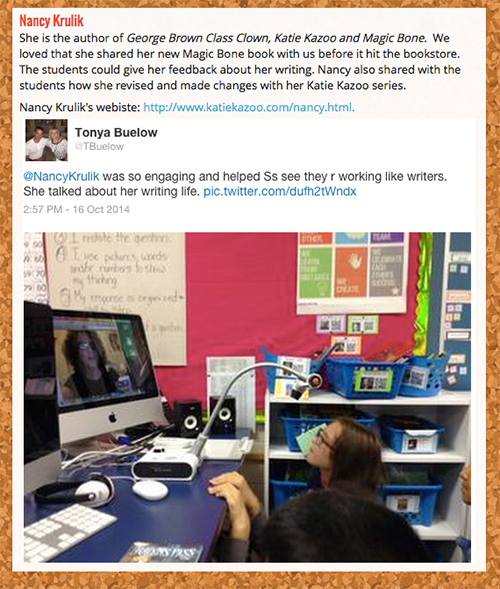
After a few weeks or so our writing workshop was beginning to have more flow and stamina. Some students would walk in first thing in the morning and share what they would be writing about later in writing workshop. I started to notice that more students were getting their ideas down on paper more fluently because they were writing more complete thoughts or sentences during independent writing time. They were thinking about writing even when it wasn’t writing time and they were making plans as writers. I started to wonder how I could possibly keep this momentum going throughout the year as we grew as writers and learned about new genres? What if I could make published authors even more accessible to the students by giving them an opportunity to interact and connect with them? What tool would allow me to do this and I instantly thought about Skype. One problem… I did not have any money to pay for Skypes and I knew that some authors charged a $100 dollars or more. I remembered my principal had shared a website called Skype in the Classroom (https://education.skype.com/).
I already had a Skype account so I logged into this website and started to explore the possibilities. To narrow the search you needed to choose a subject, so I clicked on reading and writing. Then I picked the appropriate age range. I started to browse the options and I found an author from London who was willing to Skype with elementary students. I pushed the button to register for this lesson (sometimes you might have to send an email to the publisher or author when you register). A few days later the author, Jonathan Emmett, responded via email by sending dates and times. I choose a date and time and then we emailed back and forth right before the Skype visit. I was totally amazed at how easy it was to make this connection happen. All I needed now was to have Skype installed onto the computer that projected through my Epson machine. Once the resource technology teacher completed the installation we were ready to go.
A few weeks before the Skype session I checked out books from the public library by Jonathan Emmett. As a class we read a couple of books together for pure enjoyment. We visited his website to learn a little bit more about the author. Students chose to read books by Jonathan during independent reading time and shared out their thinking about the book during share time. This extra time reading and enjoying the books sparked a sense of excitement to connect with a published author.
The day before our Skype visit I talked to the students about how we were going to get the opportunity to connect to a published author. I told the students that he would be able to talk with us and we would be able to talk to him. We discussed how we would have some time to ask Jonathan questions and we talked about what kind of questions would help us grow as writers. As a class we brainstormed some questions orally and then I asked students who were interested in asking a question to raise their hand. I gave each of them a card and they wrote down a question they would like to ask. I collected the cards so I could read through them and decide who would ask a question. I decided to do it this way because students sometimes forget the question they want to ask and questions will be repeated or asked twice. If a student had a question that he/she thought of during the Skype session I would let them ask it.
Jonathan began the session by introducing himself and asked the students what time was it in our town. He told them that it was 1:30 in the afternoon in London and the students were intrigued by the time difference. Then he read his book titled The Princess and the Pig and after the book he shared his writing process. The last 10 minutes or so was a question and answer session. Our first Skype of the year was a huge success and the students were amazed how we could talk to an author all the way in London.
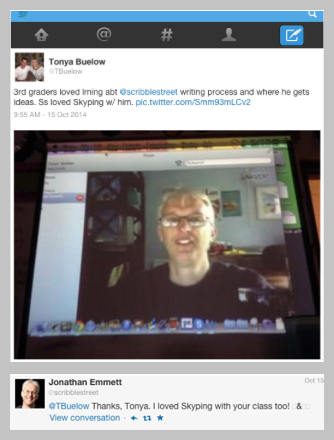
I was excited to see if there would be any shifts during independent writing time after our first conversation with a published author. I scanned the room to see if anything jumped out at me… I noticed Rana. Rana is an English Language Learner but she is bilingual in English and Arabic. As a writer it is challenging for her to come up with a writing topic. She can write simple sentences about a topic but needs strategies that will help her elaborate on her ideas. Topic choice was a writing goal for her so I have had many conferences with her on how to gather ideas as a writer in her notebook. I was excited to watch her quickly write her ideas down on paper. I walked over to celebrate how she came up with an idea on her own. I also noticed that she was playing around with a beginning that grabbed her readers’ attention. As a writer, she was trying the same crafting technique as Taylor, another student in the class. She tried to start her zoo story with dialogue. Rana no longer was struggling over topic choice and she was understanding some important things as a writer:
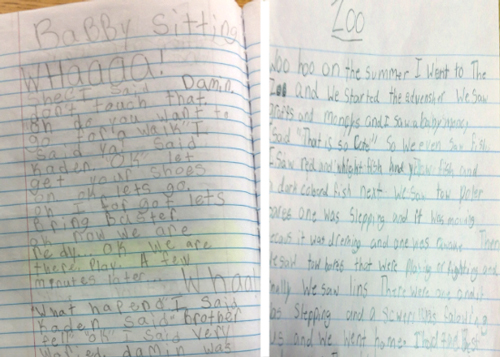
- Ideas come from everywhere
- Think about your memory bit by bit so you can capture it for your reader
- Writers learn crafting techniques from other writers
I continued to walk around and wrote similar anecdotal records about other students using a crafting technique like another writer, independently choosing a topic, or telling the story bit by bit to bring their readers in. The students were making progress because of the various levels of support within a writing workshop along with the influence from published authors. This journey was starting off well!
We did around 6 Skype visits throughout the year and each one was a purposeful and powerful connection. The opportunity to connect and hear the writing process for each author was amazing. It was truly magical to hear an author read his book and then have him share his writing process. These connections enhanced the work we did as readers and writers in our workshops because students realized they were doing authentic work with both traditional and digital tools. After each Skype session we would reflect on what we learned as writers with a quick share out. I wrote down their reflections in my notebook so that I could create an anchor chart with all our takeaways.
Author Skype Takeaways
- Writers get ideas from everywhere.
- Writers write everyday.
- Take a quick walk/break when you have writer’s block and then come back to reread your work.
- Writers revise A LOT!
- Reread your writing everyday.
- Write in a way that brings your reader in – use narrative even in nonfiction.
- Writers research for both fiction and nonfiction.
- Writers write in different genres.
- Finishing a writing a piece can take a long time.
- Writers get feedback from other writers or their editor and make changes to their writing.
- Writers share ideas with other writers.
- Writers work on more than one piece at a time.
- Some writers keep a notebook.
- Writers have a space where they work.
- Writers have ideas percolating in their head about their next writing piece.
- Constructive feedback energizes writers.
The Skype sessions gave our classroom a common connected experience with authors. This experience gave us an opportunity to reflect on how we work as a community of readers and writers. I used some of the writing advice we learned from published authors when I conferenced with students. I compared students’ writing work to authors we connected with along with other published authors whose writing we studied. For example, Maya created a nonfiction blog post about lions. She began her piece by making her readers feel like they were in Africa. As a writer she tried to write like Rebecca Johnson (we connected with her), Nicola Davies, and Valerie Bodden. She took the mini lessons we discussed along with the author connections to explore and try new crafting techniques as a writer.
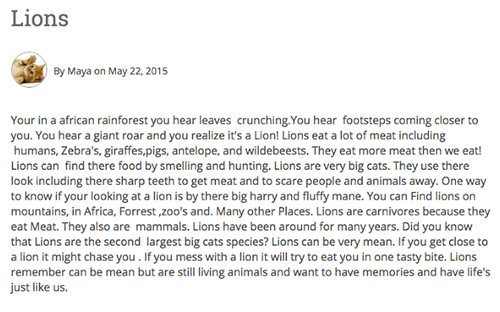
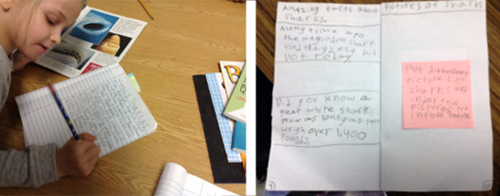 Our mini-lessons, share time and author connections helped us understand how our reading lives impact our writing lives. In the picture below you can see Jenna using her independent reading time to gather facts in her writing notebook about sharks to use in her nonfiction writing piece.
Our mini-lessons, share time and author connections helped us understand how our reading lives impact our writing lives. In the picture below you can see Jenna using her independent reading time to gather facts in her writing notebook about sharks to use in her nonfiction writing piece.
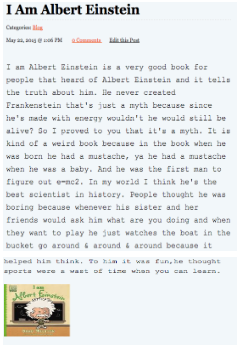
In all the Skype visits authors shared books they enjoyed as children, books that inspired them to become an author, or just books they were currently reading. Some of the authors asked the children to share books they were currently reading. The author connections and regular book talks shared by me inspired the students to share books they enjoyed with each other as a reading community. Olivia is sharing with the class a book review about a book she really enjoyed. Later on in the year these book reviews would be shared traditionally with paper and digitally through blogs. The Skypes and book reviews were another way to invite readers to explore new genres.
The connections we made with authors was another way to support the literacy framework we had in place. The advice we learned was woven into later minilessons or compared to the writing work that happened in our reading and writing community. Students started to make decisions about which pieces to publish based on feedback from other writers and which sections to revise based on peer feedback. Published authors would share marked up drafts to show how much time they spent revising their work. The author connections helped me build a more grounded concept around how and why writers revise for a series of mini-lessons. I noticed that students were editing and revising as part of the process and were becoming less dependent on me to help them with these concepts. Revising suggestions were becoming a natural flow during our share time and students were actually making changes in their work instead of saying, “I will think about what you said.” Students shifted from writing because I expected them to do it to thinking about what to write so that they can share their work with a wider audience outside our classroom walls.
I created a padlet of the authors we Skyped with last year : Author Skypes

One Snapshot of our Author Connections
There is one particular Skyping moment that I really cherished. We were Skyping with Erin Soderberg who is the author of The Quirks series and she asked the students to share what they were currently reading. Several students had shared the independent books they were reading and then I called on Tempa to share next. She said, “Well, I would like to discuss an idea I have been thinking about for my first chapter book, would you like to hear it?”
Erin replied, “Yes, I would love to hear your thoughts about your first chapter book.”
Tempa said, “Okay great, I am going to write a book titled The Journey. The main character will have an ordinary life and then her life will change when she begins to go on journeys by entering a different world where there is magic. I am still working on how she will cross into the different worlds and the different journeys she will experience.”
Erin responded, “That sounds like a great story and I would like to recommend a book that you can read that might help you get ideas for your first chapter book. The book is titled Breadcrumbs by Anne Ursu. This book might be a little challenging for you but you can check it out and see.”
Tempa replied, “Thanks I will see if I can get the book.”
As this conversation was going on my heart filled with joy and excitement. Tempa had internalized what it meant to work and think like a writer. She didn’t even hesitate to get some feedback on her next writing piece from another writer. I savored that moment for a minute before saying goodbye to Erin Soderberg. It was moments like these that made teaching so rewarding and satisfying.
I checked the book out of the library for Tempa but it was too challenging for her to read. I let her investigate the book to see if this was a book she would encourage her parents to read to her. She kept it for a couple of days and then gave it back to me. As a reader she did continue to read fantasy books that would impact her writing. Tempa decided to take her ideas out of her writing notebook and begin a rough draft. I was very intrigued that she started the book by creating the cover and wrote the synopsis to go on the back of her book. This writing piece wasn’t something she would finish that year and Tempa was okay with that. As a writer she had been playing around with this idea for a while and she learned that writing is a process and it takes time. She was willing to invest the time to work on her book outside of writing workshop and over the summer.